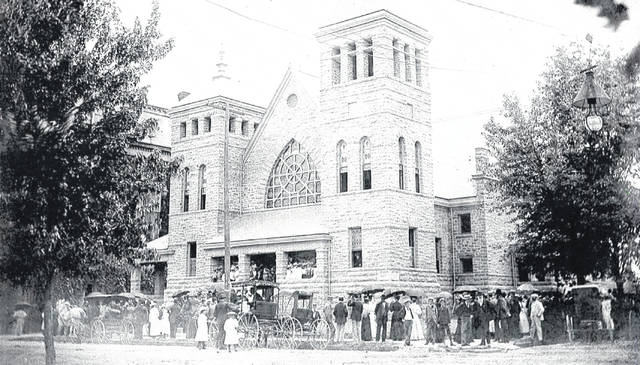
Friends — Quakers or the Religious Society of Friends — came to Clinton County very soon after the opening of the 19th century. The first established Friends meeting (or church) which stood near the intersection of Center, Orchard and Anderson roads was formally established in 1806.
Friends in Wilmington, after meeting in the homes of local Friends, received the privilege of meeting in a small brick building on West Main Street in 1825. After several years and some changes in status and locations as well as settling some theological difference, the Wilmington group in 1868 was permitted to establish a new and independent meeting (under the tutelage of Center Friends Meeting.)
There were 178 members in the newly established meeting, 119 from Center Meeting, 37 from Springfield and 22 from Dover.
This new meeting in 1870 purchased a public-school building at the location of the present building (at Locust and Mulberry). In May of 1893 a cyclone (tornado) severely damaged the building and it was decided to construct a new worship building.
The cornerstone was laid in 1895 and the new building was dedicated Aug. 18, 1896. It is said that at the time it was the finest Friends Church in the United States.
This meeting house constituted a radical departure from traditional Quaker meeting houses, which were very simple and without a steeple. (Friends then referred to conventional churches as “steeple houses.”)
This transition from, in a sense, meeting house to church or building with a steeple, was dramatic. During the Great Awakening of the late 19th century, it is said, the growth in membership in midwest Friends meetings was so great that professional leadership was needed in order to introduce the new members into Quaker belief.
This situation brought another dramatic alteration to Friends’ tradition – the hiring of paid ministers. Traditionally, all members were considered ministers and a professional leadership did not exist (these new paid ministers were referred to as “hirelings.”)
The Wilmington Friends Meeting is considered one of the first meetings with a paid minister. These innovations were centered in Indiana and Ohio.
These changes are described by Quaker Historian Tom Hamm: “By 1900 the religious sect had become virtually indistinguishable from the Protestant mainstream…” These churches now labelled Orthodox lose much of the traditional simplicity and uniqueness of unprogrammed meetings (worship herein is open and participation is based on being moved by the spirit.)
In the late 19th century and the early 20th century the Wilmington Friends Meeting flourished and possibly was the largest church in Clinton County and one of the largest meetings in the United States.
Local membership has changed over the years and has now leveled off at a significantly lower level than a hundred years ago. This is true for most area meetings, and the challenges continue.
Central to Quaker beliefs is the idea that “There is that of God in everyone.” This results in an openness to theological belief and more tolerance than is generally accepted in churches.
In faith and in practice we are part of the Christian tradition. Our commitment as followers of the life and teachings of Jesus is to serve those in need and be an active voice in our community for the Gospel of Love. Standing against war and violence and for the well-being of all of God’s creatures is sometimes unpopular, but something to which we are committed.
Our hope is that our efforts will continue and grow and that we can be an element in the continuing effort to make the world a better place for all.
Neil Snarr is Professor Emeritus of Wilmington College.


